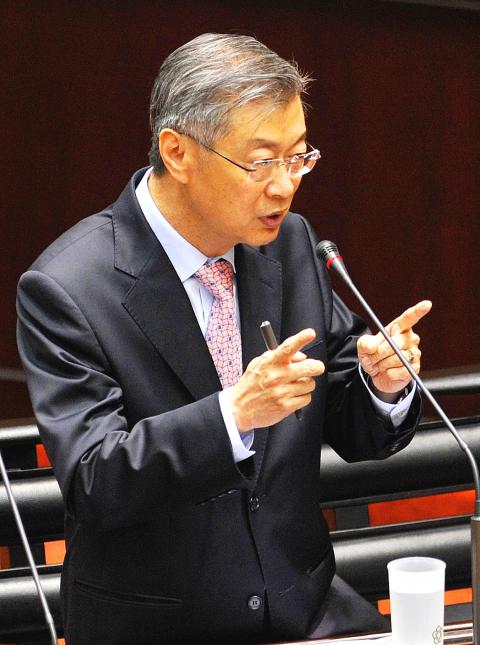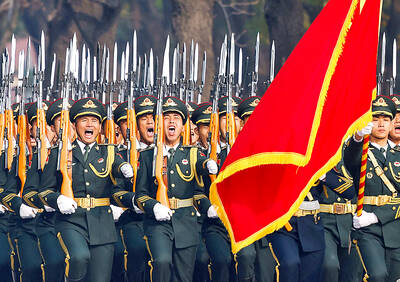Former Chinese Nationalist Party (KMT) chairman Wu Poh-hsiung’s (吳伯雄) interpretation of the cross-strait status as “one country, two areas (一國兩區)” is in accordance with the Republic of China (ROC) Constitution, which states the ROC encompasses “Taiwan and mainland China,” Presidential Office spokesman Fan Chiang Tai-chi (范姜泰基) said yesterday.
During a meeting with Chinese President Hu Jintao (胡錦濤) on Thursday, Wu touted a “one country, two areas” concept to improve cross-strait ties. Wu’s remarks drew strong disapproval from the opposition.
The Presidential Office said the administration of President Ma Ying-jeou (馬英九) continues to handle cross-strait relations under the principle of “one China,” which is the ROC.

Photo: Chien Jung-fong, Taipei Times
Ma’s stance on defending Taiwan’s sovereignty using the so-called “1992 consensus” and the principle of “one China, with each side having its own interpretation” remains unchanged, Fan Chiang said.
“President Ma’s stance [on cross-strait relations] has never changed. In the Constitution, one China refers to the ROC, and the two areas refer to Taiwan and the mainland ... The mainland is the ROC’s territory outside of Taiwan and that definition was determined more than 20 years ago in a constitutional amendment,” Fan Chiang added.
Wu is leading a delegation to China to attend the annual forum between the KMT and the Chinese Communist Party (CCP) and it is believed that he was conveying the Ma administration’s cross-strait policy for the next four years to Hu on behalf of the president.
Following the Wu-Hu meeting, vice president-elect Wu Den-yih’s (吳敦義) upcoming visit to the Boao Forum in Hainan, China, from March 31 to April 3 is the next venue for cross-strait talks. Wu Den-yih is expected to meet Chinese Vice Premier Li Keqiang (李克強) at the forum.
Fan Chiang yesterday denied that Wu Poh-hsiung proposed the new definition on cross-strait ties with Ma’s approval, insisting that the definition has not changed.
“The sross-strait status is ‘one ROC, with two areas,’ and that definition has not changed throughout the terms of two former presidents and under President Ma,” he said.
Separately yesterday, Premier Sean Chen (陳冲) echoed the Presidential Office’s statement.
The “one country, two areas” formula is “in line with our understanding” based on Article 11 of the Additional Articles of the ROC Constitution, which is why the Act Governing Relations Between the Peoples of the Taiwan Area and the Mainland Area (台灣地區與大陸地區人民關係條例) was enacted, he said.
“Wu Poh-hsiung was repeating the spirit enshrined in the Constitution’s articles,” Chen said.
Chen did not answer when asked by reporters whether he accepted the “one country, two areas” formula; instead, he asked in return: “Is there any better way to describe the article in four words?”
Earlier yesterday, at the National Affairs Forum, during which lawmakers signed up for a three-minute speech in the legislature, Taiwan Solidarity Union (TSU) Legislator Lin Shih-chia (林世嘉) put an “X” over the character for “national” on the poster board and replaced it with the character for “area.”
“Following the ‘one country, two areas’ proposal, I feel so confused. Are we at the National or Area Affairs Forum?” Lin asked.
Ma did not deserve to be the country’s president, Lin said, adding that he may as well fly to China if he wants to be “area manager.”
Democratic Progressive Party (DPP) Legislator Wu Ping-jui (吳秉叡) said the “one country, two areas” proposal proves that it is a lie that China accepts Taiwan having its own interpretation of “one China,” as Ma has previously claimed.
If China allows Taiwan room to interpret “one China” in its own way, “why didn’t KMT officials mention that in China?” he asked.
TSU Legislator Hsu Chun-hsin (許忠信) said the KMT should expel Wu Poh-hsiung from the party for downgrading the country’s status because his “one country, two areas” proposal means that Taiwan is “one area” in the People’s Republic of China (PRC).
KMT Legislator Chen Chen-hsiang (陳鎮湘) denied the DPP’s and TSU’s allegations, saying that they had wrongly interpreted the meaning of “one country,” which he said was the ROC, rather than the PRC.
Later yesterday, during a question-and-answer session in the legislature, the premier agreed with DPP Legislator Lee Chun-yi (李俊俋) that the ROC is an independent, sovereign country, and so is the PRC.
Sean Chen disagreed that the situation amounts to two Chinas, “because there is no country in the world whose official name is ‘China,’” he said.
Lee asked the premier to make a formal declaration on the floor of the legislature that the ROC is an independent, sovereign country and not an area of the PRC.
Sean Chen refused.
“It depends on how you define ‘China.’ For example, the US says that ‘China’ is a civilization. There is no country in the world formally called ‘China,’” Sean Chen said.
In response to a question from DPP Legislator Chen Chi-mai (陳其邁) on whether Shanghai, Jiangsu Province and Taiwan belonged to the same country, Sean Chen said: “In our opinion, Shanghai is still a city that belongs to the ROC. It is just that it is not under the effective control of the ROC government.”
Chen Chi-mai said the reply was “the biggest joke in the world,” to which Sean Chen replied: “I know that it’s not easy to understand for foreigners, but that is what was stipulated in the Constitution.”

The Ministry of Foreign Affairs (MOFA) yesterday said it is closely monitoring developments in Venezuela, and would continue to cooperate with democratic allies and work together for regional and global security, stability, and prosperity. The remarks came after the US on Saturday launched a series of airstrikes in Venezuela and kidnapped Venezuelan President Nicolas Maduro, who was later flown to New York along with his wife. The pair face US charges related to drug trafficking and alleged cooperation with gangs designated as terrorist organizations. Maduro has denied the allegations. The ministry said that it is closely monitoring the political and economic situation

Conflict with Taiwan could leave China with “massive economic disruption, catastrophic military losses, significant social unrest, and devastating sanctions,” a US think tank said in a report released on Monday. The German Marshall Fund released a report titled If China Attacks Taiwan: The Consequences for China of “Minor Conflict” and “Major War” Scenarios. The report details the “massive” economic, military, social and international costs to China in the event of a minor conflict or major war with Taiwan, estimating that the Chinese People’s Liberation Army (PLA) could sustain losses of more than half of its active-duty ground forces, including 100,000 troops. Understanding Chinese

UNRELENTING: China attempted cyberattacks on Taiwan’s critical infrastructure 2.63 million times per day last year, up from 1.23 million in 2023, the NSB said China’s cyberarmy has long engaged in cyberattacks against Taiwan’s critical infrastructure, employing diverse and evolving tactics, the National Security Bureau (NSB) said yesterday, adding that cyberattacks on critical energy infrastructure last year increased 10-fold compared with the previous year. The NSB yesterday released a report titled Analysis on China’s Cyber Threats to Taiwan’s Critical Infrastructure in 2025, outlining the number of cyberattacks, major tactics and hacker groups. Taiwan’s national intelligence community identified a large number of cybersecurity incidents last year, the bureau said in a statement. China’s cyberarmy last year launched an average of 2.63 million intrusion attempts per day targeting Taiwan’s critical

‘SLICING METHOD’: In the event of a blockade, the China Coast Guard would intercept Taiwanese ships while its navy would seek to deter foreign intervention China’s military drills around Taiwan this week signaled potential strategies to cut the nation off from energy supplies and foreign military assistance, a US think tank report said. The Chinese People’s Liberation Army (PLA) conducted what it called “Justice Mission 2025” exercises from Monday to Tuesday in five maritime zones and airspace around Taiwan, calling them a warning to “Taiwanese independence” forces. In a report released on Wednesday, the Institute for the Study of War said the exercises effectively simulated blocking shipping routes to major port cities, including Kaohsiung, Keelung and Hualien. Taiwan would be highly vulnerable under such a blockade, because it